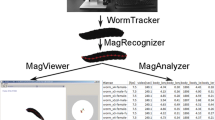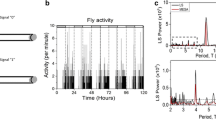Abstract
A new method to quantify locomotor behavior in Drosophila is presented, and compared with previous methods. It is based upon a radar wave, reflected by moving flies. A problem associated with the new apparatus is that its output is dependent on fly size. However, for the case the weight of the experimental flies has been determined, a correction is proposed. The method has been used by studying the effect of starvation upon locomotion in Drosophila melanogaster. It was found that starved flies are much more active than well fed flies. The importance of this effect under several conditions is discussed.
Similar content being viewed by others
REFERENCES
Angus, J. (1974). Measurement of locomotor activity in Drosophila. Anim. Behav. 22: 890-898.
Bell, W. J., and Tortorici, C. (1987). Genetic and non-genetic control of search duration in adults of two morphs of Drosophila melanogaster. J. Insect Physiol. 33: 51-54.
Burnet, B., Burnet, L. Connolly, K., and Williamson, N. (1988). Agenetic analysis of locomotor activity in Drosophila melanogaster. Heredity 61: 111-119.
Cole, B. J. (1991). Short-term cycles in ants: generation of periodicity by worker interactions. Am. Nat. 137: 244-259.
Cole, B. J. (1995). Fractal time in animal behaviour: The movement activity of Drosophila. Anim. Behav. 50: 1317-1324.
Connolly, K. J. (1966). Locomotor activity in Drosophila as a function of food deprivation. Nature (London) 209: 224.
Engelmann, W., and Mack, J. (1978). Different oscillators control the circadian rhythm of eclosion and activity in Drosophila. J. Comp. Physiol. 127: 229-237.
Ewing, A. W. (1963). Attempts to select for spontaneous activity in Drosophila melanogaster. Anim. Behav. 11: 369-378.
Hardeland, R., and Stange, G. (1971). Einflü sse von Geschlecht und Alter auf die lokomotorische Aktivitä t von Drosophila. J. Insect Physiol. 17: 427-434.
Hirsch, H. V. B., and Tompkins, L. (1994). The flexible fly: Experience-dependent development of complex behaviors in Drosophila melanogaster. J. Exp. Biol. 195: 1-18.
Hoffmann, A. A., and Cacoyianni (1990). Territoriality in Drosophila melanogaster as a conditional strategy. Anim. Behav. 40: 526-537.
Le Bourg, E., and Lints, F. A. (1984). A longitudinal study of the effects of age on spontaneous locomotor activity in Drosophila melanogaster. Gerontology 30: 79-86.
Meehan, M. J., and Wilson, R. (1987). Locomotor activity in the Tyr-1 mutant of Drosophila melanogaster. Behav. Genet. 17: 503-512.
Sewell, D. F. (1979). Effect of temperature and density variation on locomotor activity in Drosophila melanogaster: A comparison of behavioural measures. Anim. Behav. 27: 312-313.
Stange, G., and Hardeland, R. (1970). Eine methode zur Registrierung der Laufaktivitä t von kleinen Insekten. Oecologia 5: 400-405.
Van Dijken, F. R. (1982). Genetic aspects of locomotor activity of the fruitfly Drosophila melanogaster. Ph.D. Thesis, University of Utrecht, Utrecht, The Netherlands.
Van't Land, J., van Putten, P., Villaroel, H., Kamping, A., and van Delden, W. (1995). Latitudinal variation in wing length and allele frequencies for Adh and αGpdh in populations of Drosophila melanogaster from Ecuador and Chile. Dros. Inf. Serv. 76: 156.
Van't Land, J. (1997). Latitudinal variation in Drosophila melanogaster. On the maintenance of the world-wide polymorphism for Adh, αGpdh and In(21)t. Ph.D. Thesis, University of Groningen, Groningen, The Netherlands.
Von Skrzipek, K. H., Krö ner, B., and Hager, H. (1979). Aggression bei Drosophila melanogaster—Laboruntersuchungen. Z. Tierpsychol. 49: 87-103.
Ye., S., Aracena, J., Good, D. S., and Bell, W. J. (1994). Correlation between survival during food deprivation and search behavior in populations of Drosophila melanogaster. J. Insect Physiol. 40: 137-142.
Zonta, L. A., Costa, R., and M. Osti (1992). Genetic analysis of fickle locomotor behavior in Drosophila melanogaster. J. Genet. 71: 1-9.
Author information
Authors and Affiliations
Rights and permissions
About this article
Cite this article
Knoppien, P., van der Pers, J.N.C. & van Delden, W. Quantification of Locomotion and the Effect of Food Deprivation on Locomotor Activity in Drosophila. Journal of Insect Behavior 13, 27–43 (2000). https://doi.org/10.1023/A:1007759424777
Issue Date:
DOI: https://doi.org/10.1023/A:1007759424777




